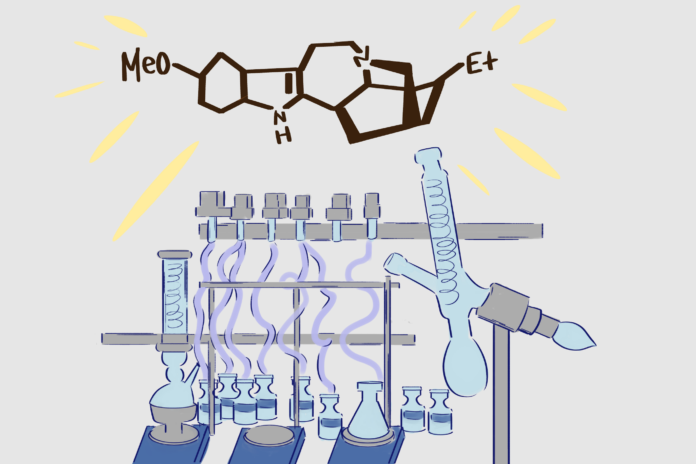Researchers at the UC Davis Institute of Psychedelics and Neurotherapeutics have finished the total synthesis of a scarce, naturally found anti-addiction/antidepressant agent
By NAREN KRISHNA JEGAN — science@theaggie.org
Ibogaine, a psychoactive compound derived from African plants like the iboga shrub (Tabernanthe iboga) and the small-fruited voacanga tree (Voacanga africana), has long been recognized for its potential in treating addiction and depression.
However, its natural scarcity and association with cardiac risks have limited its medical applications. In a groundbreaking study published in “Nature Chemistry,” researchers at UC Davis’ Institute for Psychedelics and Neurotherapeutics (IPN) have successfully synthesized ibogaine and its analogues from pyridine, a widely available and inexpensive chemical.
Led by Rishab Iyer, who received a Ph.D. from UC Davis in 2023, and Professor David E. Olson, the team developed a strategy to create ibogaine-related alkaloids with significantly improved efficiency. Previous synthesis attempts faced low yields and complex chemical pathways, but this new method produces ibogaine analogues in just six to seven steps, with yields ranging from 6 to 29%. This advancement allows for large-scale production without depleting natural plant resources and opens new doors for medicinal chemistry and organic synthesis research.
Organic synthesis is the process of constructing complex molecules from simpler chemical building blocks. In total synthesis, chemists design step-by-step methods to create natural products like ibogaine from non-natural sources.
“Accessing sufficient quantities of natural ibogaine for clinical trials has proven challenging as it is produced in small quantities, and overharvesting of T. iboga negatively impacts cultures that use it for spiritual purposes,” the study reads.
Using organic synthesis techniques, these problems can be avoided in a clever manner.
“[Using] semi-synthesis from the more abundant natural product voacangine offers a potential solution, as does efficient total synthesis from readily available building blocks,” the study reads.
One of the biggest challenges to consider in the production of ibogaine is the compound’s unique and complex structure. Imagine trying to build a puzzle where certain pieces must fit together in a specific way. Scientists overcame this by using a series of chemical reactions, including one where they “snap” different pieces of the molecule together in a controlled way. Their new approach uses key steps such as regioselective reduction, a Diels-Alder cycloaddition and epimerization to build the molecule efficiently.
Ibogaine’s potential as a treatment for substance use disorders, traumatic brain injuries and neuropsychiatric diseases is gaining traction, despite its risk of causing irregular heartbeats. Olson’s team sought to understand how ibogaine interacts with biological systems by studying its molecular structure and testing analogues.
One key discovery was that only the natural form of ibogaine, not its mirror image, promoted neuronal growth, indicating a specific receptor interaction.
“Nature only produces one version and if the therapeutic effects of ibogaine are coming from interactions with another chiral entity, like an enzyme or receptor, then you would expect only the natural version to have an effect,” Olson said. “If it’s non-specific, then both compounds would produce an effect.”
Another notable analogue, (-)-10-fluoroibogamine, demonstrated strong effects on neuronal growth and serotonin transporters, which play a crucial role in depression treatment. This analogue exhibited rewiring of the brain in a way that supports addiction recovery and mental health improvement.
Olson emphasized the need for an “Ibogaine 2.0” — a safer alternative that retains the compound’s therapeutic benefits without cardiac risks. By making ibogaine analogues more accessible and studying their biological mechanisms, researchers aim to develop next-generation treatments for addiction and mental health disorders.
This research’s importance also lies in its ability to make ibogaine more accessible for scientific studies and medical use while avoiding environmental harm. More importantly, it lays the foundation for developing safer treatments for addiction and mental health conditions. The ability to create modified versions of ibogaine with improved safety profiles could revolutionize treatment options for patients worldwide.
Written by: Naren Krishna Jegan





